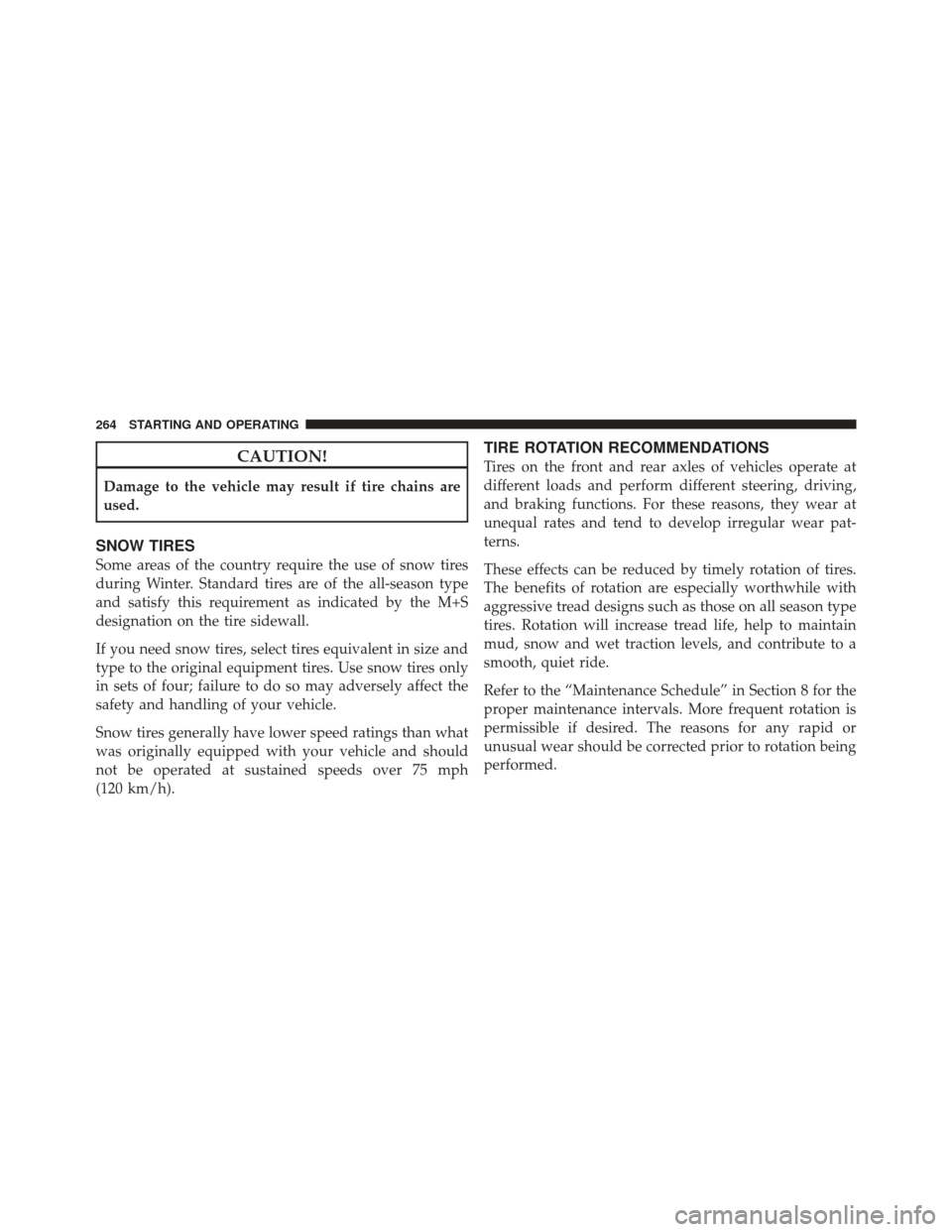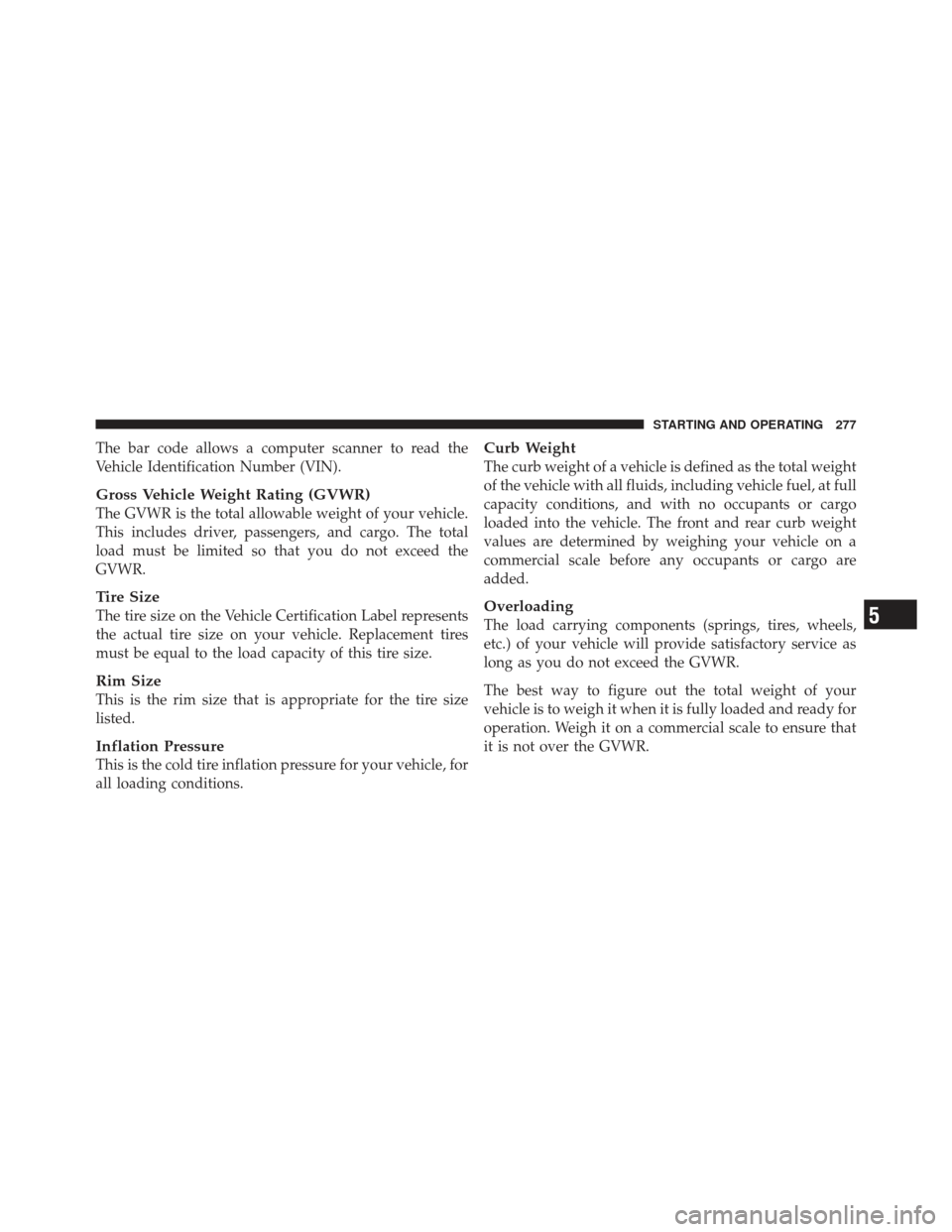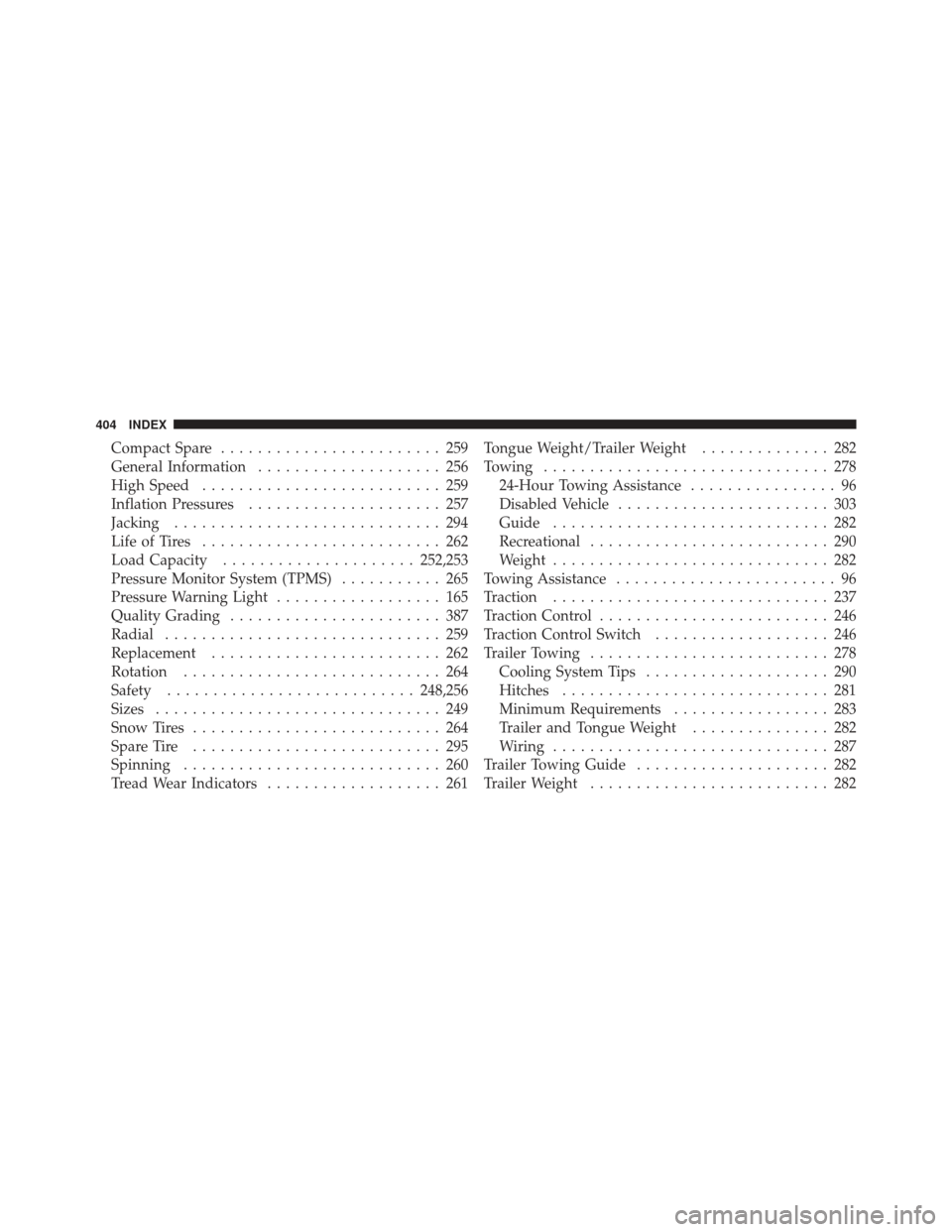tire size CHRYSLER PT CRUISER 2009 1.G User Guide
[x] Cancel search | Manufacturer: CHRYSLER, Model Year: 2009, Model line: PT CRUISER, Model: CHRYSLER PT CRUISER 2009 1.GPages: 410, PDF Size: 5.24 MB
Page 265 of 410

WARNING!
•Do not use a tire, wheel size or rating other than
that specified for your vehicle. Some combinations
of unapproved tires and wheels may change sus-
pension dimensions and performance characteris-
tics, resulting in changes to steering, handling, and
braking of your vehicle. This can cause unpredict-
able handling and stress to steering and suspen-
sion components. You could lose control and have
an accident resulting in serious injury or death.
Use only the tire and wheel sizes with load ratings
approved for your vehicle.
•Never use a tire with a smaller load index or
capacity, other than what was originally equipped
on your vehicle. Using a tire with a smaller load
index could result in tire overloading and failure.
You could lose control and have an accident.(Continued)
WARNING! (Continued)
•Failure to equip your vehicle with tires having
adequate speed capability can result in sudden tire
failure and loss of vehicle control.
CAUTION!
Replacing original tires with tires of a different size
may result in false speedometer and odometer read-
ings.
TIRE CHAINS
Due to limited clearance, tire chains are not recom-
mended.
5
STARTING AND OPERATING 263
Page 266 of 410

CAUTION!
Damage to the vehicle may result if tire chains are
used.
SNOW TIRES
Some areas of the country require the use of snow tires
during Winter. Standard tires are of the all-season type
and satisfy this requirement as indicated by the M+S
designation on the tire sidewall.
If you need snow tires, select tires equivalent in size and
type to the original equipment tires. Use snow tires only
in sets of four; failure to do so may adversely affect the
safety and handling of your vehicle.
Snow tires generally have lower speed ratings than what
was originally equipped with your vehicle and should
not be operated at sustained speeds over 75 mph
(120 km/h).
TIRE ROTATION RECOMMENDATIONS
Tires on the front and rear axles of vehicles operate at
different loads and perform different steering, driving,
and braking functions. For these reasons, they wear at
unequal rates and tend to develop irregular wear pat-
terns.
These effects can be reduced by timely rotation of tires.
The benefits of rotation are especially worthwhile with
aggressive tread designs such as those on all season type
tires. Rotation will increase tread life, help to maintain
mud, snow and wet traction levels, and contribute to a
smooth, quiet ride.
Refer to the “Maintenance Schedule” in Section 8 for the
proper maintenance intervals. More frequent rotation is
permissible if desired. The reasons for any rapid or
unusual wear should be corrected prior to rotation being
performed.
264 STARTING AND OPERATING
Page 268 of 410

TPMS will continue to warn you of low tire pressure as
long as the condition exists, and will not turn off until the
tire pressure is at or above the recommended cold
placard pressure. Once the low tire pressure warning has
been illuminated, you must increase the tire pressure to
the recommended cold placard pressure in order for the
Tire Pressure Monitoring Telltale Light to turn off. The
system will automatically update and the TPMS Telltale
Light will turn off once the system receives the updated
tire pressures. The vehicle may need to be driven for up
to 20 minutes above 15 mph (25 km/h) in order for the
TPMS to receive this information.
For example, your vehicle may have a recommended
cold (parked for more than three hours) placard pressure
of 33 psi (227 kPa). If the ambient temperature is 68°F
(20°C) and the measured tire pressure is 28 psi (193 kPa),
a temperature drop to 20°F (-7°C) will decrease the tire
pressure to approximately 24 psi (165 kPa). This tire
pressure is sufficiently low enough to turn ON the TPMSTelltale Light. Driving the vehicle may cause the tire
pressure to rise to approximately 28 psi (193 kPa), but the
TPMS Telltale Light will still be ON. In this situation, the
TPMS Telltale Light will turn OFF only after the tires are
inflated to the vehicle’s recommended cold placard pres-
sure value.
CAUTION!
The TPMS has been optimized for the original
equipment tires and wheels. TPMS pressures and
warning have been established for the tire size
equipped on your vehicle. Undesirable system opera-
tion or sensor damage may result when using re-
placement equipment that is not of the same size,
type, and/or style. Aftermarket wheels can cause
sensor damage. Do not use aftermarket tire sealants
or balance beads if your vehicle is equipped with a
TPMS, as damage to the sensors may result.
266 STARTING AND OPERATING
Page 279 of 410

The bar code allows a computer scanner to read the
Vehicle Identification Number (VIN).
Gross Vehicle Weight Rating (GVWR)
The GVWR is the total allowable weight of your vehicle.
This includes driver, passengers, and cargo. The total
load must be limited so that you do not exceed the
GVWR.
Tire Size
The tire size on the Vehicle Certification Label represents
the actual tire size on your vehicle. Replacement tires
must be equal to the load capacity of this tire size.
Rim Size
This is the rim size that is appropriate for the tire size
listed.
Inflation Pressure
This is the cold tire inflation pressure for your vehicle, for
all loading conditions.
Curb Weight
The curb weight of a vehicle is defined as the total weight
of the vehicle with all fluids, including vehicle fuel, at full
capacity conditions, and with no occupants or cargo
loaded into the vehicle. The front and rear curb weight
values are determined by weighing your vehicle on a
commercial scale before any occupants or cargo are
added.
Overloading
The load carrying components (springs, tires, wheels,
etc.) of your vehicle will provide satisfactory service as
long as you do not exceed the GVWR.
The best way to figure out the total weight of your
vehicle is to weigh it when it is fully loaded and ready for
operation. Weigh it on a commercial scale to ensure that
it is not over the GVWR.5
STARTING AND OPERATING 277
Page 406 of 410

Compact Spare........................ 259
General Information .................... 256
High Speed .......................... 259
Inflation Pressures ..................... 257
Jacking ............................. 294
Life of Tires .......................... 262
Load Capacity ..................... 252,253
Pressure Monitor System (TPMS) ........... 265
Pressure Warning Light .................. 165
Quality Grading ....................... 387
Radial .............................. 259
Replacement ......................... 262
Rotation ............................ 264
Safety ........................... 248,256
Sizes ............................... 249
Snow Tires ........................... 264
Spare Tire ........................... 295
Spinning ............................ 260
Tread Wear Indicators ................... 261 Tongue Weight/Trailer Weight
.............. 282
Towing ............................... 278
24-Hour Towing Assistance ................ 96
Disabled Vehicle ....................... 303
Guide .............................. 282
Recreational .......................... 290
Weight .............................. 282
Towing Assistance ........................ 96
Traction .............................. 237
Traction Control ......................... 246
Traction Control Switch ................... 246
Trailer Towing .......................... 278
Cooling System Tips .................... 290
Hitches ............................. 281
Minimum Requirements ................. 283
Trailer and Tongue Weight ............... 282
Wiring .............................. 287
Trailer Towing Guide ..................... 282
Trailer Weight .......................... 282
404 INDEX